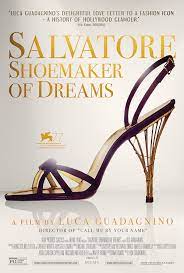
SALVATORE, SHOEMAKER OF DREAMS
Italy, 2020, 109 minutes, Colour.
Narrated by Michael Stuhlbarg.
Directed by Luca Guadagnino.
Italian Director, Luca Guadagnino, has built up a reputation for award-winning dramatic films for two decades – I am Love, a Bigger Splash, Call Me by Your Name – and a number of short films, television series, documentaries. After this documentary, he made Bones and All.
This is a documentary made with some affection. Its subject is Salvatore Ferragamo, born in Bonita, a village east of Naples, 1898 (and dying in 1960). From a big family, he discovered very early that he had a talent for making shoes, making shoes for his sister’s First Communion, then in the village, all before he was 10. He spent time in Naples, as an apprentice, with a flare for a creative designing and hands-on making of shoes.
At the time of World War I, he sailed to the United States, third class, but a kindly crewmember smuggling him into second-class for some comfort. Going through Ellis Island, having given some money for his comfort, he wrapped note around paper, which was accepted, is having the right amount of money to enter America. He stayed with his brothers, especially a brother in Boston who was in a shoe making factory. However, he then decided to go to the West Coast,, making his shoes, settling in Santa Barbara, able to join the early filmmaking studios, making cowboy boots, especially, which helped his reputation.
With the closing of the studio in Santa Barbara, and the establishing in 1919 of Hollywood, he moved there, was noticed, made shoes for a great variety of stars (and images of the stars for whom he created footwear). He also studied at the University of Southern California, Los Angeles, with particular attention to feet. At the opening of the film, the audience has been introduced to feet, with narrated voice-over of Salvatore explaining the wonders of the human foot, structure, engineering, importance for balance…
In 1927, he returned to Italy, setting up a shop in Florence where he worked during the fascist era, and during the war. This era, with his increasing lack of material, made demands on the creativity of Salvatore, not just in shape and design of shoes, but in the variety of materials that could be used during wartime scarcity is.
There are quite a number of talking heads throughout the film, including Martin Scorsese. And there are many images of the great range of Hollywood stars for whom he provided shoes, especially after World War II. He was a celebrity, even as he worked in Florence.
The film also highlights his meeting with Christian Dior, their winning an award, Marcus-Niemann, in 1947 and comparing notes, comparing their similarity of perspective on design.
A later age, he decided that he wanted to be married, fell in love at first sight with wonder, married her, had six children. Throughout the film there is testimony from wander, but also from several of the children, the company still being managed by the family.
While this is a portrait of Salvatore Ferragamo, and there is his spoken narrative, many photos, some home movies which he took, it is not as if we really meet him as personally as we would like. We know something about him, admire him, but, despite Guadagnino is technique, he seems something of a character more than a person.
Ultimately, there is a startling variety of shoes on display, in close-up, shapes, sizes, materials, colours, heels…, even a little designed ballet of shoes at the end of the film.
A very engaging documentary, the story of poverty and achievement, craft and talent, a successful migration to the US, a successful return to Italy, success and reputation worldwide.